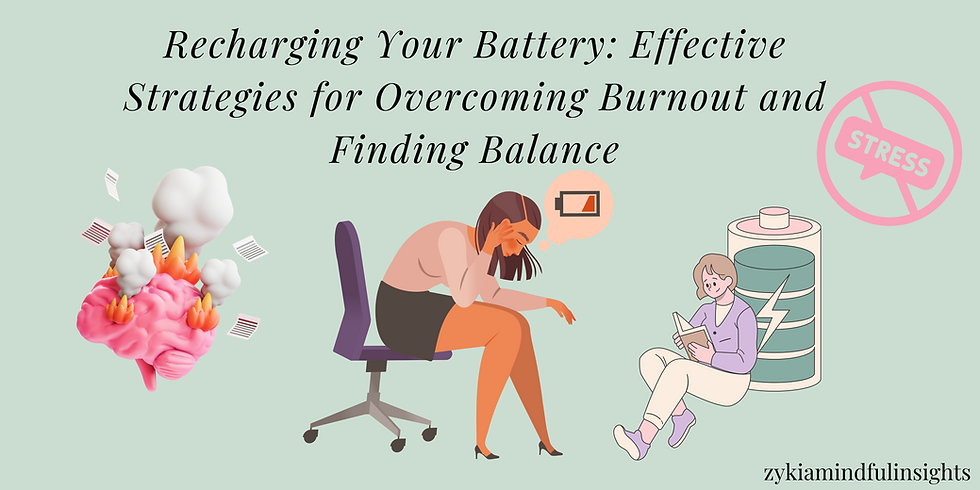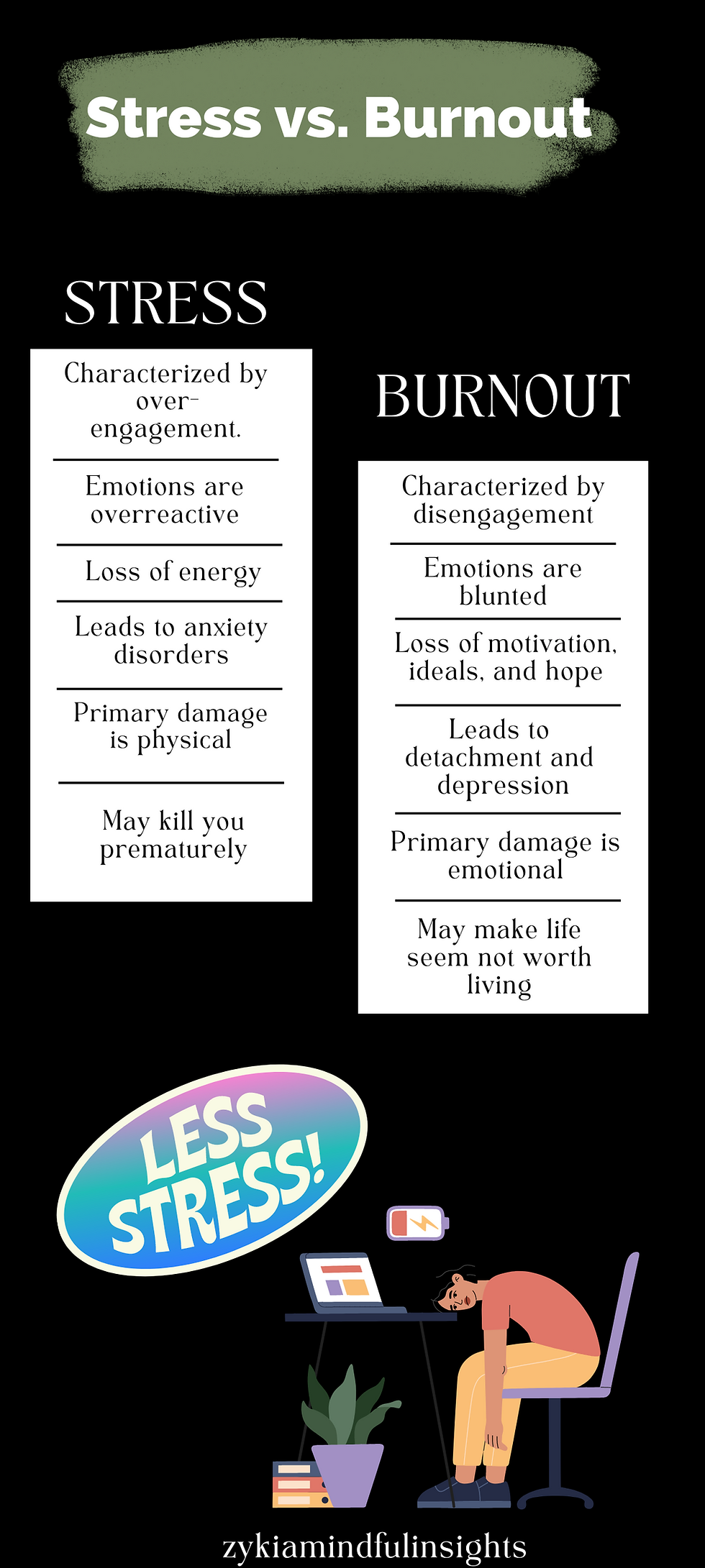Recharging Your Battery: Effective Strategies for Overcoming Burnout and Finding Balance
- Zykia Hannah

- Mar 6, 2024
- 6 min read

What is Burnout?
Burnout is a state of emotional, physical, and mental exhaustion caused by excessive and prolonged stress. Here are some strategies that can help in overcoming burnout:
Identify the Signs: Learn to recognize the signs and symptoms of burnout. This includes feeling emotionally drained, disconnected from work and other commitments, and experiencing a lack of motivation.
Set Boundaries: Establish boundaries between work and personal life. For example, avoid checking work emails or taking work calls during off hours.
Prioritize Self-care: Make time for activities that you enjoy and that help you relax and recharge. This can include exercise, hobbies, spending time with loved ones, or practicing mindfulness and meditation.
Delegate Tasks: Don't try to do everything yourself. Delegate tasks when possible and ask for help when needed.
Breaks and Time Off: Take regular breaks throughout the day and use your vacation time to rest and recharge.
Seek Support: Talk to someone you trust about how you're feeling. This could be a friend, family member, or mental health professional.
Focus on What You Can Control: Concentrate on what you can control and let go of things that are beyond your control. This can help reduce feelings of overwhelm.
Learn to Say No: Don't take on more than you can handle. Practice saying no to extra responsibilities or commitments that will only add to your stress.
Reevaluate Your Goals: Take a step back and reassess your priorities and goals. Are they still aligned with your values and desires? Adjust them if necessary.
Seek Professional Help: If you're struggling to overcome burnout on your own, consider seeking help from a therapist or counselor. They can provide support and guidance tailored to your specific situation.
Remember, overcoming burnout is a process that takes time and effort. Be patient with yourself and don't be afraid to ask for help when needed.
In today's fast-paced world, where demands on our time and energy seem endless, experiencing burnout is all too common. However, it doesn't have to be a permanent state. By adopting specific strategies and making mindful choices, we can regain our energy, reconnect with our passions, and create a more balanced and fulfilling life. This article explores a range of techniques for overcoming burnout, from setting boundaries to prioritizing self-care, offering a roadmap to reclaiming a sense of harmony and vitality.
I.
Burnout is a state of chronic stress that leads to emotional, physical, and mental exhaustion. It’s caused by prolonged exposure to demanding situations, and it can affect every aspect of our lives. Understanding how to identify and overcome burnout is crucial for our well-being.
II. Identifying Burnout
a. Signs and symptoms of burnout: Feeling chronically tired, lack of motivation, irritability, reduced productivity, feeling overwhelmed.
b. Recognizing burnout: Ask yourself, “Do I feel exhausted most of the time? Is work or daily life a constant source of stress? Am I feeling less and less engaged in activities I usually enjoy?”
c. Acknowledging burnout: Accepting that you’re experiencing burnout is the first step to overcoming it. It’s okay to feel this way, and you’re not alone.
III. Setting Boundaries
a. Importance of boundaries: They protect our time and energy and help prevent us from overcommitting.
b. Tips for setting boundaries: Communicate your limits clearly, learn to say no, and prioritize what truly matters.
c. Overcoming resistance: Feeling guilty or anxious about setting boundaries is normal, but remember, it’s an essential step in taking care of yourself.
IV. Prioritizing Self-care
a. The role of self-care: It’s not selfish; it’s essential for our well-being. It includes activities that help us recharge, relax, and connect with ourselves.
b. Examples of self-care: Exercise, hobbies, reading, spending time with loved ones, or simply taking a break and doing nothing.
c. Incorporating self-care: Make time for it in your daily schedule, and treat it as a non-negotiable part of your routine.
V. Seeking Support
a. The importance of talking: Sharing your feelings with someone you trust can provide emotional relief and validation.
b. Who to turn to: Friends, family members, coworkers, or a mental health professional.
c. Finding support: If you don’t have a support system, consider joining a support group, or seek help from a therapist or counselor.
VI. Focusing on What You Can Control
a. Letting go: Identify things that are beyond your control and practice letting go of them.
b. Managing stress: Find healthy ways to cope with stress, such as deep breathing, exercise, or meditation.
c. Embracing imperfection: Nobody’s perfect, and it’s okay to make mistakes. Treat yourself with kindness and compassion.
VII.
a. Recap of strategies: Identify burnout, set boundaries, prioritize self-care, seek support, focus on what you can control.
b. Encouragement: Overcoming burnout is possible with dedication and self-compassion. Take small steps every day to regain balance and vitality.
c. Final thoughts: Remember, it’s okay to ask for help and to take care of yourself. You deserve it.
VIII. Additional Resources
a. Links to further reading: Articles, books, or websites about burnout and stress management.
b. Recommended self-help books: Suggestions for books that can provide additional guidance and support.
c. Professional help: Information on where to find a therapist or counselor if needed.
"Caring for myself is not self-indulgence, it is self-preservation, and that is an act of political warfare." — Audre Lorde.
Signs and symptoms of burnout
We all have days when we feel overwhelmed or undervalued—when even getting out of bed feels like an impossible feat. If you find yourself feeling this way more often than not, you might be experiencing burnout. Burnout is a slow process that builds over time, beginning with subtle signs that intensify over time. These initial signs are like early warnings, indicating that something isn't right and needs attention. By recognizing these signals and taking steps to manage stress, you can prevent a full-fledged burnout. Ignoring them, however, could lead to a complete breakdown.
Physical signs and symptoms of burnout
Feeling tired and drained most of the time.
Lowered immunity, frequent illnesses.
Frequent headaches or muscle pain.
Change in appetite or sleep habits.
Emotional signs and symptoms of burnout
Sense of failure and self-doubt.
Feeling helpless, trapped, and defeated.
Detachment, feeling alone in the world.
Loss of motivation. Increasingly cynical and negative outlook.
Decreased satisfaction and sense of accomplishment.
Behavioral signs and symptoms of burnout
Withdrawing from responsibilities.
Isolating from others.
Procrastinating, taking longer to get things done.
Using food, drugs, or alcohol to cope.
Taking frustrations out on others.
Skipping work or coming in late and leaving early.
Stress vs. Burnout

Causes of burnout
Though often linked to work, burnout can affect anyone feeling undervalued and overwhelmed, from the devoted office professional deprived of a break to the tireless stay-at-home parent juggling numerous roles. However, the causes of burnout are not solely attributed to work or responsibilities. Lifestyle choices and personal traits also significantly contribute to burnout. In fact, one's leisure activities and perspective can be just as crucial in creating stress overload as job or household obligations.
Work-related causes of burnout
Feeling like you have little or no control over your work.
Lack of recognition or reward for good work.
Unclear or overly demanding job expectations.
Doing work that’s monotonous or unchallenging.
Working in a chaotic or high-pressure environment.
Lifestyle causes of burnout
Working too much, without enough time for socializing or relaxing.
Lack of close, supportive relationships.
Taking on too many responsibilities, without enough help from others.
Not getting enough sleep.
Personality traits can contribute to burnout
Perfectionistic tendencies; nothing is ever good enough.
Pessimistic view of yourself and the world.
The need to be in control; reluctance to delegate to others.
High-achieving, Type A personality.
Dealing with burnout
Whether you’re noticing the early signs of burnout or already feeling its full force, attempting to push through the exhaustion and continue as usual can lead to further emotional and physical harm. It's crucial to pause and change direction by exploring ways to help yourself overcome burnout and restore your health and optimism.
Addressing burnout involves the “Three Rs”:
- Recognition: Be vigilant for the warning signs of burnout.
- Reversal: Undo the damage by seeking assistance and managing stress.
- Resilience: Bolster your resilience to stress by nurturing your physical and emotional well-being.
These tips for preventing or handling burnout can assist you in managing symptoms and regaining vitality, concentration, and a sense of well-being.
🩷Quote of the day:
“Learn to value yourself, which means: fight for your happiness.” ― Ayn Rand




Comentários